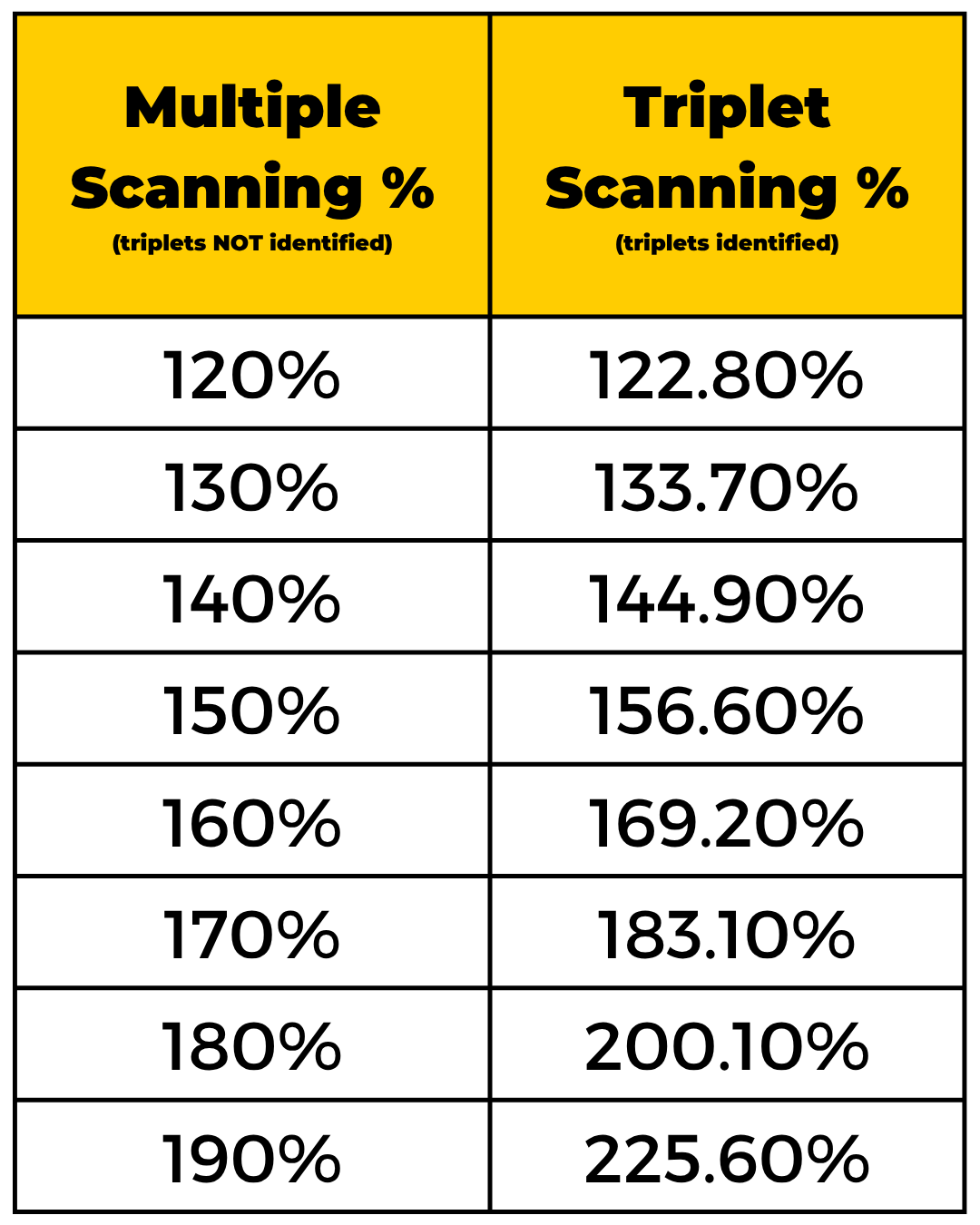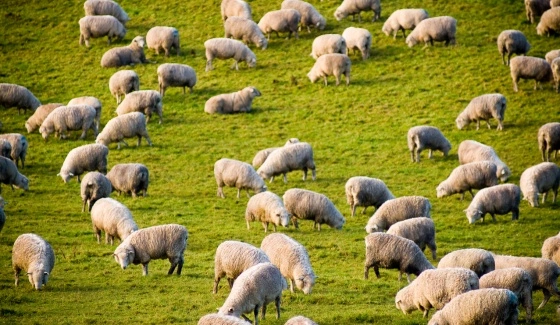
When I mention triplets to most farmers, I’m met with a mildly pained look, maybe even an eye-roll. It’s understandable; they’re difficult to manage, and as we improve production as an industry, each year we come across more and more of them within our flocks, and they’re getting harder and harder to ignore.
Triplets are typically lighter at birth, with average birth weights around 3.6 kg, approximately 66% of the average single lamb weight of 5.5 kg. The survival rate of triplet lambs is notably lower compared to single and twin lambs, and studies have shown that the average survival rate for triplet lambs is approximately 67.5%, compared to 89.5% for single lambs and 85.5% for twins.
Luckily for us, there have been many scientists and farmers alike who have trialled different ways of managing triplets, and the results consistently show that with the right management, triplet survival can improve up to 80% or more. But to manage them well, you need to know who they are, so we’ll start with the basics of identifying your triplets at scanning.
Scanning for triplets
Many people scan for multiples, which only gives you a dry, single or twin scanning result. In the table below, you can see what your actual scanning percentage is if you also identify triplets.

As you get closer to scanning 180%, the more triplet-bearing ewes you will have. So, it is worth considering scanning for triplets, even considering the extra cost. If you apply the management tactics below, it pays for itself in increased survival in both your ewes and lambs.
Managing triplets pre-lamb
The main thing to consider for triplet-bearing ewes is how limited their rumen capacity is in the weeks before birth. At that point, the mismatch between a ewe’s nutritional demands and her rumen capacity is at its most extreme. She requires 42% more energy than in early pregnancy, whilst her rumen can only hold 60-70% of its normal capacity. This gap is what makes this period of pregnancy so risky for all ewes, but especially triplets, and is why it is important to aim to have your triplet-bearing ewes at a body condition score (BCS) of 3.5 before lambing, so they have the fat reserves to carry them through.
One thing to point out is that during late pregnancy, a ewe cannot just keep shedding weight until she gets to a BCS 2. A buffer helps, but a sheep can only lose so much body condition during that period without there being metabolic impacts. During this phase in pregnancy, the body prioritises the growing fetuses’ needs over the ewe’s own maintenance requirements. And, if she is in an energy deficit for too long, it impacts her at a cellular level, leading to pregnancy toxaemia. So, if you are not scanning for triplets - and thus feeding your triplets the same as twins and keeping them in a deficit for too long - you have a higher chance of losing some triplet-bearing ewes to pregnancy toxaemia.
Knowing how difficult it is to meet the nutritional demands of triplet-bearing ewes during late pregnancy, we can now understand the importance of feeding triplet ewes well earlier in that pregnancy. You only have a short window to put on that fat reserve before the energy demand-intake gap gets too big.
If your triplet numbers are increasing to the point where you have a substantial mob of them, there have been successes with grazing triplets pre-lamb on high-herbage crops such as plantain and clover. By feeding your ewes on a high-quality, energy-dense crop, you make sure that every mouthful is helping fill that feed gap mentioned above. Lambing ewes on the crop and keeping them on there until weaning also means you are improving the nutrition offered to the triplet lambs.
Managing triplets at lambing
We often hear discussions on what is the best type of lambing paddock for triplets. Opinions vary, but it seems that no one really has anything ‘ideal’ because the ideal for triplets is quite specific, and often it seems contradictory to offer your best paddock to a few high-risk animals. Below are a few things that make up an ideal triplet lambing paddock:
- A good amount of high-quality feed (1,500 kg/dm/Ha +).
- Ideally, a flat paddock, so ewes can more easily keep track of their three lambs.
- Privacy from other ewes.
- Shelter from the elements.
You don’t often have enough triplets to allocate an entire (decent) paddock to them, which adds another layer to your decision-making.
When trying to decide where to lamb your triplets, my advice is to pick some elements from the list that you can match and just do your best. If you have built up the BCS profile of your triplets pre-lamb, there is slightly more leeway in terms of pasture availability, and maybe you can focus on privacy. If you know your BCS isn’t there, the focus should be on high-quality feed, and so on.
There really isn’t anything like seeing a ewe who’s reared three lambs herself, knowing you all got through that challenging period successfully. Lots of ewes can do it if given the chance, so don’t sell them short by ‘tucking them away’ somewhere that is not ideal.
Triplets around the world
In many other countries, scanning percentages often sit higher, meaning that triplets, and sometimes even up to quintuplets, are the ‘norm’ for them. Because of this, and their intensive management style, many have perfected various ways to improve survival.
One off, one on
Many places that lamb indoors give a triplet lamb to a single-bearing ewe to ensure each ewe rears twins. This is labour-intensive, but when your sheep are housed, it is just a case of getting the right method in place, and it is often highly successful (and is a very cost-effective method). If you want any tips on wet adoptions, send me a message or email.
Supplementing triplet lambs
I have worked on a few farms that fed cold artificial milk to triplet lambs. They would turn triplets out into a nearby paddock and place a simple milk feeder with three to eight teats on a fence, topping it up daily. They often supplemented their triplet ewes in the same area, and any hungry lambs soon came to realise there was supplementary milk available. This filled the gap for the lambs and reduced the pressure on the ewes, too. Obviously, this introduces a cost, but not as much as the method below.
Artificially raising the third lamb
Some places just take off the weakest triplet and artificially rear it. If you have a good lamb-rearing set-up and your survivability rates from that are high, this can often result in increased numbers of lambs weaned, but it does reduce profits due to labour and milk/feed prices.
How to avoid triplets?
In an ideal world, every ewe would have two lambs. And to some extent, we can breed sheep to be more likely to have twins. In nProve, there is a TWIN breeding value (although it is not often quoted in ram catalogues), and so genetic pressure can be put on reducing triplets in highly fecund flocks.
The breeding value is calculated by looking at the lambing records of the daughters of sires. The number of lambs born is affected by ovulation rate and embryonic mortality. Sheep with the genetic propensity to have higher embryonic mortality will be more likely to have varying litter sizes. Conversely, sheep with less embryonic mortality show less variation in litter size. It helps balance the productivity equation by reducing the number of triplet births while maintaining the overall scanning percentage. It is only 2% heritable, so genetic progress will be slow, but still achievable.
Best practice management of triplet-bearing ewes and their lambs
Whilst we can slowly genetically influence the number of triplets born, the immediate solution is to improve our management practices by considering all that has been mentioned above.
Luckily for us, the science on how to manage triplets has been thoroughly researched, and the information is readily available. Meat & Livestock Australia recently released excellent, comprehensive technical guides on triplet management. Rather than me reinventing the wheel, you can find the documents at the link below:
- Triplet best practice guide: maternal, Meat & Livestock Australia, 2024
- Triplet best practice guide: merino, Meat & Livestock Australia, 2024
Triplets really don’t need to be as scary as people make them out to be. Not long ago, the thought of twins in merino sheep garnered the same response - and look at where we are now.
If you would like to chat more about triplet management, get in touch with me at sophie@nextgenagri.com.
___
Join the conversation on The Hub
Take a moment to head over to the neXtgen Agri Hub to share your thoughts and questions on managing triplet-bearing ewes and their lambs.
___
You might also be interested in ...
- Breeding for higher lamb survival by Dr Mark Ferguson (article)
- Reducing lamb wastage: scanning to birth by Sophie Barnes (article)
- Reducing lamb wastage: birth to weaning by Sophie Barnes (article)
- Subdividing paddocks to lamb ewes in smaller mobs by Dr Amy Lockwood (article)
- Triplet management with John Young and Sophie Barnes (webinar)
- Have you done a lambing paddock audit? by Sophie Barnes (article)
- Ewe-lamb bonding behaviours at birth are affected by maternal undernutrition in pregnancy




.jpg)




